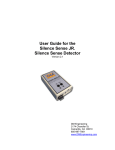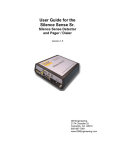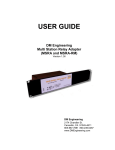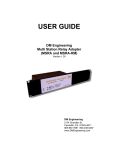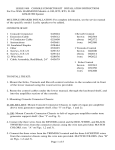Download User Manual for the
Transcript
User Guide for the Silence Sense JR. Silence Sense Detector Version 2.2 DM Engineering 2174 Chandler St. Camarillo, CA 93010 805-987-7881 800-249-0487 www.DMEngineering.com Theory of Operation The Silence Sense Jr. is a microprocessor-based device that senses the presence of audio from a single ended input over a wide range of input levels. A user adjustable input control and a yellow LED indicator are used to set the input sensitivity. When the audio input ceases for a predetermined user selectable period, (1 min. or 4 min. maximum timeout depending upon the internal jumper setting), a set of normally open relay contacts are closed. These contacts may be momentary or continuous, depending on user switch selection. An internal jumper may be installed to change the relay output to normally closed contacts if desired. A red LED indicator signals when the preset time period has been exceeded and remains on until audio is firmly reestablished. The reapplication of audio automatically resets the device. Power for the device is supplied by a “wall wart” power supply. (Either polarity power supply output is acceptable as the unit employs “Power Guard” which steers the proper polarity to the Silence Sense Jr.) Battery back-up (9V) is provided to assure operation when the power fails. Both external and battery back-up power are disconnected when the power switch is in the off position. Connections 1. Audio input…A single ended audio source is attached to the Eurostyle style connector positive and ground inputs. Observe polarity. 2. Relay output…Eurostyle type screw terminal, Normally Open, rated at 2 A. This connection goes in series with the indicator, sounder or other circuit desired. (Normally Closed is available, see section 4 in Setup) 3. Power input…With the Silence Sense Jr. power switch in the off position, connect the “wall wart” DC output connector to the power input jack on the front of the unit. Plug the “wall wart” into a convenient 117VAC outlet. 4. Battery back-up…Remove the bottom battery compartment door by pressing down and outward on the door when viewed from the bottom. Locate the battery that was shipped with the unit and connect the battery to the snap on battery connector in the compartment and replace the door. Setup 1. With audio present at the input, set the power switch to the on position. Slowly adjust the gain adjust control in the clockwise direction until the yellow LED glows at full brilliance at low audio passages. Depending on your programming, this level may need to be readjusted for reliable audio detection later. 2. Adjust the duration set control to the desired timeout period. Fully counterclockwise is approximately 3 (5) seconds, mid-setting is 30 seconds (2 min), and fully clockwise is approximately 60 seconds (approximately 4 min.). You may set the control to any position desired. Note that after the adjustment is made it is recommended that the audio input be momentarily turned off and back on to reset the microprocessor. This is true any time the duration set adjustment is changed. The red LED will signify when the timeout period has been reached. 3. The Silence Sense Jr. is supplied set for a 4 minute maximum timeout period as a default value unless otherwise requested at the time of order. To set the unit to one minute, remove the 4 rubber feet that are hiding the access screws on the bottom of the cabined. Remove the top cover and locate the “Timeout” jumper, J1, and move it to the “1” position. See figure 1 below. Fig. 1 4. To change the relay contacts to Normally Closed, open the cabinet as instructed in step 3 and cut the wire jumper marked “NO”. Insert and solder another wire jumper in the “NC” position, or, in later versions, move the jumper from the NO position to the NC position. See figure 2. Fig. 2 5. Select momentary “M” or continuous “C” relay operation using the relay output selector switch. See figure 3. Fig. 3 Operation and test To test the Silence Sense Jr., remove the audio input and wait for the red LED and relay to activate. This will be the actual delay time, and may be reset at will. Remember to momentarily remove audio to reset the microprocessor each time this adjustment is changed. To test the battery back-up operation, simply disconnect the external power. The Silence Sense Jr. should continue to function normally. That’s it… the Silence Sense Jr. is now ready and waiting to monitor your audio. Hints Most programming has pauses from time to time that may last for 30 seconds or more, especially if you are broadcasting Sunday morning church services. Experience has taught that 45-60 seconds is the best selection if you don’t want to receive false alarms. Also, take time in setting the input levels. Wait and watch the yellow LED through different types of programming or selections of music and speech to assure that the sensitivity is set correctly. Specifications • Input Impedance: 10K ohms minimum, single ended, Eurostyle terminal block connector • Input Level: -30 to +10 dbm, input adjustable • Silence Detect Time: 3-60 seconds or 5 seconds to 4 min. (approx.), user adjustable • Output: Normally open single pole relay contacts, 2 A rating @ 30 VDC, 1 second momentary or continuous closure...switch selectable, Eurostyle terminal block connector output • Power Requirements: Supplied adapter, 115 VAC to 9-12 VDC, 100-500 ma. • Battery Back-up Requirements: 9 VDC alkaline battery, NEDA 1604A (supplied) • Size: 4.4 x 2.6 x 1.1 • Shipping Weight: Approximately 2 lbs.




